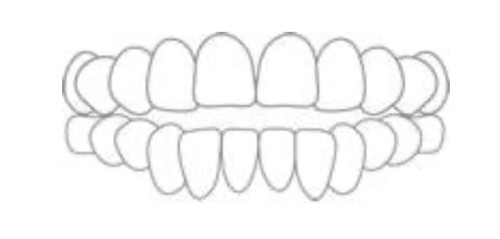The Digital Set-Up in Orthodontics
10 février 2025
Clear Aligners: Alternative to Conventional Orthodontic Systems
Nowadays, patient demand for orthodontic treatment continues to grow, particularly among adults. These patients, who are especially conscious of their appearance, seek treatments that are both fast and discreet—like clear aligners.
Some patients refuse to undergo treatment with fixed multi-bracket appliances. After ceramic brackets and lingual orthodontics, the development of transparent braces has provided an aesthetic solution that has attracted millions of patients worldwide.
Today, people can correct misaligned teeth and malocclusions without visible brackets and wires. Instead, dentists use nearly invisible, transparent braces for treatment.
A brief history
It all began in 1997 in Santa Clara, California, when two orthodontists, a computer engineer, and two MBA students founded the startup Align Technology, with a single idea in mind: digitally aligning teeth.
CAD/CAM (Computer Aided Design / Computer Aided Manufacturing) enabled the digital scanning of dental arches and the creation of a virtual model. Allowing for a step-by-step digital setup (ClinCheck) of the treatment plan.
3D printing, through the solidification of liquid resin via stereolithography (SLA), made it possible to manufacture a series of dental aligners from 3D images.
The combined use of these two techniques led to the development of an innovative aligner system, marketed under the name Invisalign.
What Are Aligners?
A dental aligner is a custom-made medical device fabricated by 3D printing. It is a transparent removable tray made of thermoformable polymer that moves teeth by applying gentle, controlled forces.
Using a series of clear aligners, each for a different phase of treatment, offers a new option. The practitioner plans this process using special software. This method is a modern alternative to traditional multi-bracket treatments.

Figure 1
Technique Development
In 1998, Align’s Invisalign system was approved by the FDA, allowing for its commercial release in 1999.
By 2000, this pioneering aligner system had arrived in France.
After several years, many of the underlying patents expired, enabling other companies worldwide to develop and market their own Invisalign-type systems.
This led to the wider democratization of this revolutionary therapy, making it more accessible.
Today, several aligner systems exist—such as Clear Aligner, Essix, e-cligner, Smilers by Biotech Dental, Spark, Access Aligner, Twin Aligner by Orthocaps, Aligneurs Français, among others.
However, Invisalign still tops the rankings, with over 12 million patients treated worldwide.
How Do Orthodontic Aligners Work?
The core principle of alignment with transparent trays is to plan the treatment in advance.
A special software program helps create a digital setup for each treatment stage. It models tooth movements in 3D, leading to the final result.
This enables highly precise control over tooth movement over the weeks. Once the treatment plan is defined and validated, a series of aligners is produced for the patient.
The 3D-printed aligners exert gentle pressure on the teeth, causing a gradual shift. As a result, patients must wear them at least 22 hours a day to achieve the expected outcome. They should only remove them for eating, drinking, or toothbrushing.
The orthodontist changes transparent braces regularly, typically every two weeks on average, until the teeth reach the final position they predefined.
Additional accessories designed to facilitate more precise dental movements—known as attachments—are bonded to the surface of certain teeth. The design team plans these composite resin “buttons” from the outset to help correct rotations, torque, or intrusion/extrusion movements.
Advantages Over Conventional Orthodontic Techniques
As their name suggests, invisible aligners are transparent and therefore very discreet. Once worn, they are very difficult to notice in the mouth.
This is a major advantage for patients who are apprehensive about wearing traditional orthodontic appliances, particularly due to the aesthetic impact of brackets on their professional and social lives, especially for adults. These clear aligners address this cosmetic concern and offer an interesting alternative.
Compared to traditional metal braces, which are often rigid and bulky with brackets and bands, these aligners are much more comfortable. They are thin, lightweight, flexible, and smooth since they are made from biocompatible polymers. As a result, trauma and iatrogenic lesions (such as irritation, injuries, and bleeding) are virtually nonexistent with this type of treatment.
Aligners are completely removable, allowing patients to avoid the hassle of a fixed appliance that can be cumbersome and difficult to maintain. Patients can take them out to eat, drink, brush their teeth, or clean them. However, aside from meals and brushing, they must be worn for at least 22 hours per day to ensure maximum effectiveness.
These aligners are also particularly appealing because they are easy to clean. Unlike multi-bracket braces, their maintenance is much simpler. Maintaining good oral hygiene is sufficient since the aligners are removed during meals. Additionally, they can be cleaned with a toothbrush and special cleaning crystals designed for the aligner’s polymer material.
Moreover, aligner treatment is significantly less restrictive than traditional braces, as it requires fewer check-ups with the dentist. A visit every three months may be sufficient.
Finally, digital technology plays a key role in this process, as it facilitates communication with the patient. It helps explain the treatment plan and its progress while encouraging compliance with the prescribed protocol to achieve the best results.
Potential Drawbacks of Clear Aligners
- Patient Compliance: This is a key factor for success. Patients might forget to wear their aligners, use them the wrong way, or even lose them. This can disrupt treatment and lower its effectiveness.
- Esthetics: Occasionally, saliva may be visible through the aligners, or small shadows can appear if attachments are placed on anterior teeth.
- Posterior Tooth Intrusion: Aligners have a certain thickness that can result in a slight interarch spacing, sometimes leading to undesirable posterior tooth intrusion.
When Can Invisible Aligners Be Used?
-
These aligners are indicated for treating mild to moderate malocclusions.
- Dental Crowding (DDM <5 mm): Crowding often leads to plaque buildup and thus to pathogenic germs responsible for periodontal disease and tooth decay. Brushing and using floss or interdental brushes becomes difficult in such cases.
- Diastema Closure: Beyond the cosmetic concern, spacing can weaken the gingiva and periodontium because of food impaction and pocket formation.


-
- Deep Bite (Overbite): An excessive vertical overlap (>2 mm) of the maxillary anterior teeth over the mandibular anterior teeth can lead to dental wear, gum injuries, or jaw pain.
- Open Bite: The opposite of overbite, where there is insufficient vertical overlap of anterior teeth. This can cause speech problems, chewing difficulty, and premature tooth wear.
- Anterior Open Bite: Absence of vertical overlap; the maxillary and mandibular anterior teeth do not touch when in occlusion, affecting chewing and incising.
- Cross-Bite: When in occlusion, some maxillary teeth are positioned inside the mandibular teeth, causing excessive wear and periodontal damage if untreated.
- Young Patients in Mixed Dentition: Aligners can help expand the jaw or correct parafunctional habits (thumb sucking, tongue thrust) and thus reduce or simplify future orthodontic treatment phases.
- Orthodontic Treatments With or Without Extraction and as a preparation for ortho-surgical treatments.
Limits of Aligner Therapy
Certain clinical cases require treatments other than aligners, for example: crowding or spacing (DDM) >10 mm, anteroposterior discrepancies >5 mm, or vertical tooth movements >5 mm.
Some movements are difficult to achieve with aligners, such as rotations >30°, large tooth inclinations (>45°), tooth intrusion, or expansions over 4 mm.
Contraindications
Certain clinical situations contraindicate the use of clear aligners, notably known allergies to polymer materials, compromised general health status, or poor oral hygiene.
From Diagnosis to Aligner Placement
As with any orthodontic therapy, a comprehensive diagnosis is essential at the first appointment. An aligner-trained practitioner must perform:
- A thorough medical and dental history
- Extraoral exam with photographs
- Intraoral exam
- Occlusal-functional assessment
- Radiographic exams (panoramic and lateral cephalometric)
- Assessment of skeletal maturity and growth curve
- Analysis of craniofacial morphology
Dental impressions are also taken to prepare study models.
By synthesizing the collected data, the clinician can form an esthetic, functional, dento-periodontal, alveolar, and skeletal diagnosis in all three spatial dimensions (transverse, vertical, and sagittal). This allows for establishing objectives and a treatment plan.
Once the first trays arrive, the practitioner shows the patient how to place and remove them. They also teach how to clean and care for the trays. Each aligner is typically worn for up to two weeks. Several sets of aligners are provided to the patient at the same appointment.
The patient must change aligners according to the prescribing practitioner’s instructions. This protocol generally allows for quarterly follow-up visits to ensure the treatment is proceeding correctly and to monitor tooth movements. New sets of aligners can be fabricated until the final result is achieved.
When treatment is done and the teeth are straight, the patient needs to wear a retainer at night. This should continue for several months to keep the results stable. Afterward, the dentist can put in a fixed, invisible, and permanent retainer. They bond a small wire to the back surfaces of the teeth using composite resin.
Influence of Material Properties on Aligner Forces
The material used to fabricate aligners must be flexible, inert, biocompatible, and resistant. It should also have good resilience and excellent molding characteristics.
The polymer type (polypropylene, polyethylene, polyurethane), the various additives in the resin, and any reinforcements can alter the aligner’s chemical, physical, and mechanical properties—explaining potential differences in treatment outcomes.
With low levels of activation, the material type influences the force delivered.
An 18 g force can move teeth. An Invisalign® aligner made of EX30 polyurethane starts with about 200 g. This force then decreases steadily by about 40 g in less than an hour.
Orthodontic Biomechanics of Aligners
Orthodontic biomechanics involves understanding how the periodontal apparatus responds to the forces exerted upon it. These forces vary according to:
- Direction
- Magnitude
- Distribution
- Duration
The resultant of these forces causes the intended tooth movements but can also produce unwanted, “parasitic” movements.
A transparent tray fits closely over virtually the entire tooth surface, optimizing tooth movement. The intimate contact between the aligner and tooth crown ensures the precise, programmable transmission of force.
When a new transparent braces is placed in the mouth, it exerts a nearly continuous force whose intensity drops quickly. You must wear each aligner for at least 22 hours a day. Periods of rest within the periodontal tissues facilitate remodeling.
Typically, people wear each aligner for 1–2 weeks on average.
Each aligner can produce about 1° of torque, 2° of rotation, and 0.25–0.3 mm of tooth movement.
Recent studies suggest that clear braces work better when changed more often. However, more aligners are needed to reach the same treatment goal with gentler, gradual forces.
Conclusion
Clear aligners represent a relevant therapeutic alternative to other orthodontic techniques. They have their own indications based on specific biomechanics and should be used judiciously. Like any medical treatment, they have limitations and contraindications.
Their main uses are to fix mild misalignments. This includes minor crowding in young adults or small relapses after teen orthodontic treatment. They can also benefit older adults, for example, to correct tooth migration caused by periodontal problems.
Combining transparent braces with other orthodontic or surgical techniques can expand the scope of invisible trays.
Patient compliance, accurate diagnosis, and mastery of orthodontic biomechanics are the key factors for successful aligner treatment.
Looking ahead, the democratization of this revolutionary therapy continues, making clear aligners ever more accessible in modern orthodontic practice.
